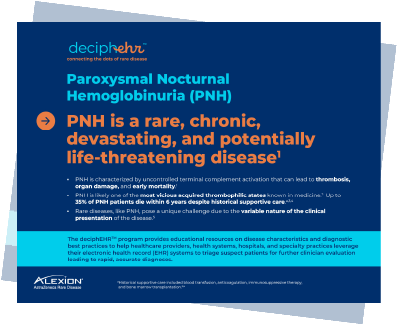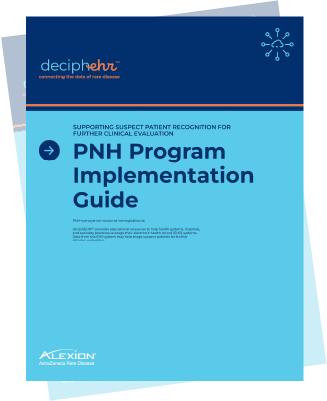PNH is a rare, chronic, devastating, and potentially life-threatening disease1
- PNH is characterized by uncontrolled terminal complement activation that can lead to thrombosis, organ damage, and early mortality1
- PNH is likely one of the most vicious acquired thrombophilic states known in medicine.2 Up to 35% of PNH patients die within 6 years despite historical supportive care3,4,a
- Rare diseases, like PNH, pose a unique challenge due to the variable nature of the clinical presentation of the disease5
Take action with an PNH toolkit.
Leveraging EHRs may help health organizations triage patients for further evaluation6
Why is early PNH patient recognition important?

of patient deaths attributed to PNH were due to venous or arterial thrombosis. While the first clot/thrombotic event can be deadly, the second is 5-10x more likely to lead to mortality.7,8

Chronic activation of terminal complement is associated with severe morbidities, including renal damage and pulmonary hypertension, and early mortality.1,9

Patients with PNH are significantly impacted by symptoms such as severe fatigue, impaired quality of life (QoL), and the inability to keep up with essential activities of daily living (eg, 17.4% became unemployed or working less and 26.3% missed work).10

Delays in diagnosis and misdiagnosis have been found to significantly worsen physical PNH symptoms, cause increase in psychological disorders, and decrease trust in the healthcare system.11
EHR=electronic health record.
aHistorical supportive care included blood transfusion, anticoagulation, immunosuppressive therapy,
and bone marrow transplantation.3,4
References: 1. Sharma VR. Paroxysmal nocturnal hemoglobinuria: pathogenesis, testing, and diagnosis. Clin Adv Hematol Oncol. 2013;11(9)(suppl 13):2-8. 2. Luzzatto L, Gianfaldoni G, Notaro R. Management of paroxysmal nocturnal haemoglobinuria: a personal view. Br J Haematol. 2011;153(6):709-720. 3. Kelly RJ, Hill A, Arnold LM, et al. Blood. 2011;117(25):6786-6792. 4. Loschi M, Porcher R, Barraco F, et al. Am J Hematol. 2016;91(4):366-370. 5. Röth A, Maciejewski J, Nishimura JI, Jain D, Weitz JI. Screening and diagnostic clinical algorithm for paroxysmal nocturnal hemoglobinuria: expert consensus. Eur J Haematol. 2018;101(1):3-11. 6. Ben-Assuli O, Sagi D, Leshno M, Ironi A, Ziv A. Improving diagnostic accuracy using EHR in emergency departments: a simulation-based study. J Biomed Inform. 2015;55:31-40. 7. Hill A, Kelly RJ, Hillmen P. Thrombosis in paroxysmal nocturnal hemoglobinuria. Blood. 2013;121(25):4985-4996. 8. Hillmen P, Muus P, Dührsen U, et al. Blood. 2007;110(12):4123-4128. 9. Hillmen P, Elebute M, Kelly R, et al. Am J Hematol. 2010;85(8):553-559. 10. Schrezenmeier H, Muus P, Socié G, et al. Baseline characteristics and disease burden in patients in the International Paroxysmal Nocturnal Hemoglobinuria Registry. Haematologica. 2014;99(5):922-929. 11. Mitchell R, Salkeld E, Chisolm S, Clark M, Shammo JM. Path to diagnosis of paroxysmal nocturnal hemoglobinuria: the results of an exploratory study conducted by the Aplastic Anemia and MDS International Foundation and the National Organization for Rare Disorders utilizing an internet-based survey. SM Clin Med Oncol. 2017;1(1):1001.




